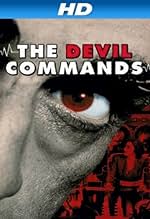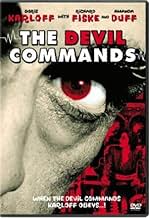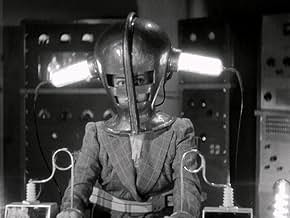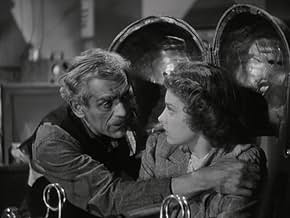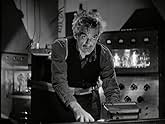NOTE IMDb
6,1/10
1,5 k
MA NOTE
Ajouter une intrigue dans votre langueScientist becomes obsessed with the idea of communicating with his dead wife.Scientist becomes obsessed with the idea of communicating with his dead wife.Scientist becomes obsessed with the idea of communicating with his dead wife.
Ernie Adams
- Elam
- (non crédité)
Lester Allen
- Dr. Van Den
- (non crédité)
Wheaton Chambers
- Dr. Sanders
- (non crédité)
Earl Crawford
- Johnson
- (non crédité)
Harrison Greene
- Mr. Booth, Bakery Proprietor
- (non crédité)
Erwin Kalser
- Professor Kent
- (non crédité)
Eddie Kane
- Professor Walt
- (non crédité)
George McKay
- Station Agent
- (non crédité)
Al Rhein
- Truck Driver
- (non crédité)
Histoire
Le saviez-vous
- AnecdotesCompleted December 1940, released February 3, 1941.
- GaffesDr. Julian tells Mrs. Walters she had 10,000 volts pass through her body. Volts do not flow or pass, amps do.
- Citations
Dr. Julian Blair: Anne dear, your mother is not dead, not really. She's come back to me!
- ConnexionsFeatured in Hollywood and the Stars: Monsters We've Known and Loved (1964)
Commentaire à la une
As for another viewer, this film was deposited in my memory banks a generation ago. This morning (4 Sept 2007) the TCM screen stirred that memory, so I taped and replayed the conclusion. The content is thin but the film is short, at least for a grown-up. Karloff is splendid, perfectly absorbed as ever in his character. His role is well supported by the evil medium-familiar woman with regulation severely-pulled-back hair. Dmytryk's touch is in evidence already, as every scene is well composed and lighted.
But the reason why the film stuck in my aging memory, and the only reason for it to attract attention, is the stunningly realized seance scenes at the end. As other posters have described, this isn't just any seance: most of the participants have already crossed over, but they look bewitchingly cool sheathed in deco metal suits. (Another poster called them diving suits, but more like space suits you'd find on the covers of Amazing Tales in that era.) In classic seance style, all these suited bodies are seated around a table.
As in Frankenstein and so many other movies since, the action in the lab scene mostly involves turning up the juice, which pours through the whole interlinked seance, adding a lot of hypnotic background noise. (And can be defended historically, since Spiritualists often used electro-magnetic metaphors to describe their rapport.)
What happens then testifies to a lesson later film-makers probably can't re-learn: nothing is more suggestive than restraint. In two concluding scenes where Karloff finally gets the experiment up and running the way he planned, this well-built seance scenario comes to partial but mesmerizing life. A spinning vortex appears at the bodies' center. The voice of Karloff's dead wife breaks through in a grinding electronica: "Julian!"
Then a lovely, unpredictable action: the seance cadavers in their space suits move ever so slightly, bowing toward the vortex in a series of click-actions. Then, when the electricity ceases, they click back into upright postures. Just as the Karloff character hears his wife's voice, something strangely suggestive of life beyond death occurs. The scene lasts only seconds but is repeated for the mob-finale. It's like an Eric Clapton solo, where you're touched less by what is actually played than all that might have been played. The performance stops at its peak moment, launching the audience's imagination in a way that extensions of the scene could never have accomplished.
But the reason why the film stuck in my aging memory, and the only reason for it to attract attention, is the stunningly realized seance scenes at the end. As other posters have described, this isn't just any seance: most of the participants have already crossed over, but they look bewitchingly cool sheathed in deco metal suits. (Another poster called them diving suits, but more like space suits you'd find on the covers of Amazing Tales in that era.) In classic seance style, all these suited bodies are seated around a table.
As in Frankenstein and so many other movies since, the action in the lab scene mostly involves turning up the juice, which pours through the whole interlinked seance, adding a lot of hypnotic background noise. (And can be defended historically, since Spiritualists often used electro-magnetic metaphors to describe their rapport.)
What happens then testifies to a lesson later film-makers probably can't re-learn: nothing is more suggestive than restraint. In two concluding scenes where Karloff finally gets the experiment up and running the way he planned, this well-built seance scenario comes to partial but mesmerizing life. A spinning vortex appears at the bodies' center. The voice of Karloff's dead wife breaks through in a grinding electronica: "Julian!"
Then a lovely, unpredictable action: the seance cadavers in their space suits move ever so slightly, bowing toward the vortex in a series of click-actions. Then, when the electricity ceases, they click back into upright postures. Just as the Karloff character hears his wife's voice, something strangely suggestive of life beyond death occurs. The scene lasts only seconds but is repeated for the mob-finale. It's like an Eric Clapton solo, where you're touched less by what is actually played than all that might have been played. The performance stops at its peak moment, launching the audience's imagination in a way that extensions of the scene could never have accomplished.
- FosterAlbumen
- 3 sept. 2007
- Permalien
Meilleurs choix
Connectez-vous pour évaluer et suivre la liste de favoris afin de recevoir des recommandations personnalisées
- How long is The Devil Commands?Alimenté par Alexa
Détails
- Durée1 heure 5 minutes
- Couleur
- Rapport de forme
- 1.37 : 1
Contribuer à cette page
Suggérer une modification ou ajouter du contenu manquant

Lacune principale
By what name was The Devil Commands (1941) officially released in India in English?
Répondre

